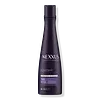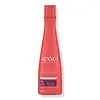What's inside
What's inside
 Key Ingredients
Key Ingredients

 Benefits
Benefits

 Concerns
Concerns

 Ingredients Side-by-side
Ingredients Side-by-side

Water
Skin ConditioningCetearyl Alcohol
EmollientDimethicone
EmollientCollagen Amino Acids
MoisturisingStearamidopropyl Dimethylamine
EmulsifyingLactic Acid
BufferingBehentrimonium Chloride
PreservativeHydrolyzed Elastin
EmollientHydrolyzed Keratin
HumectantOryza Sativa Extract
AbsorbentParfum
MaskingDipropylene Glycol
HumectantAmodimethicone
1,2-Hexanediol
Skin ConditioningBenzyl Alcohol
PerfumingTrehalose
HumectantPhenoxyethanol
PreservativeDisodium EDTA
Gluconolactone
Skin ConditioningSodium Chloride
MaskingPEG-7 Propylheptyl Ether
Emulsion StabilisingCetrimonium Chloride
AntimicrobialSodium Sulfate
Iodopropynyl Butylcarbamate
PreservativeWater, Cetearyl Alcohol, Dimethicone, Collagen Amino Acids, Stearamidopropyl Dimethylamine, Lactic Acid, Behentrimonium Chloride, Hydrolyzed Elastin, Hydrolyzed Keratin, Oryza Sativa Extract, Parfum, Dipropylene Glycol, Amodimethicone, 1,2-Hexanediol, Benzyl Alcohol, Trehalose, Phenoxyethanol, Disodium EDTA, Gluconolactone, Sodium Chloride, PEG-7 Propylheptyl Ether, Cetrimonium Chloride, Sodium Sulfate, Iodopropynyl Butylcarbamate
Water
Skin ConditioningCetearyl Alcohol
EmollientDimethiconol/Silsesquioxane Copolymer
Skin ConditioningStearamidopropyl Dimethylamine
EmulsifyingIsohexadecane
EmollientCetyl Palmitate
EmollientGlutamic Acid
HumectantCysteine Hcl
AntioxidantSerine
MaskingGlycine
BufferingHistidine Hcl
Skin ConditioningHydrolyzed Keratin
HumectantCollagen Amino Acids
MoisturisingHydrolyzed Elastin
EmollientBehentrimonium Chloride
PreservativeCitric Acid
BufferingParfum
MaskingGlycerin
HumectantDipropylene Glycol
HumectantSodium Benzoate
MaskingSodium Gluconate
Skin ConditioningSodium Chloride
MaskingDisodium EDTA
Sodium Citrate
BufferingCetrimonium Chloride
AntimicrobialHexyl Cinnamal
PerfumingCI 19140
Cosmetic ColorantCI 17200
Cosmetic ColorantWater, Cetearyl Alcohol, Dimethiconol/Silsesquioxane Copolymer, Stearamidopropyl Dimethylamine, Isohexadecane, Cetyl Palmitate, Glutamic Acid, Cysteine Hcl, Serine, Glycine, Histidine Hcl, Hydrolyzed Keratin, Collagen Amino Acids, Hydrolyzed Elastin, Behentrimonium Chloride, Citric Acid, Parfum, Glycerin, Dipropylene Glycol, Sodium Benzoate, Sodium Gluconate, Sodium Chloride, Disodium EDTA, Sodium Citrate, Cetrimonium Chloride, Hexyl Cinnamal, CI 19140, CI 17200
Ingredients Explained
These ingredients are found in both products.
Ingredients higher up in an ingredient list are typically present in a larger amount.
This ingredient is a preservative and often used for it's anti-static properties. You'll most likely see this ingredient in hair conditioners.
It does not cause irritation or sensitization in leave-on products at 1-5%.
Cetearyl alcohol is a mixture of two fatty alcohols: cetyl alcohol and stearyl alcohol. It is mainly used as an emulsifier. Emulsifiers help prevent the separation of oils and products. Due to its composition, it can also be used to thicken a product or help create foam.
Cetearyl alcohol is an emollient. Emollients help soothe and hydrate the skin by trapping moisture.
Studies show Cetearyl alcohol is non-toxic and non-irritating. The FDA allows products labeled "alcohol-free" to have fatty alcohols.
This ingredient is usually derived from plant oils such as palm, vegetable, or coconut oils. There is debate on whether this ingredient will cause acne.
Due to the fatty acid base, this ingredient may not be Malassezia folliculitis safe.
Learn more about Cetearyl AlcoholThis ingredient is a preservative, antimicrobial, and emulsifier. It is often used in cosmetics for its ability to cleanse, condition, and reduce static.
Cetrimonium chloride is a quaternary ammonium salt, meaning it has a water-soluble structure.
Collagen amino acids are naturally found in the outermost layer of your skin.Your body uses amino acids to build collagen and elastin.
Due to their tiny size, amino acids are able to be absorbed into the skin. They mostly play a role in keeping your skin hydrated and reinforcing your NMF (natural moisturizing factors).
Dipropylene Glycol is a synthetically created humectant, stabilizer, and solvent.
This ingredient helps:
Dipropylene glycol is technically an alcohol, but it belongs to the glycol family (often considered part of the ‘good’ alcohols). This means it is hydrating and gentle on skin unlike drying solvent alcohols like denatured alcohol.
As a masking agent, Dipropylene Glycol can be used to cover the smell of other ingredients. However, it does not have a scent.
Studies show Dipropylene Glycol is considered safe to use in skincare.
Learn more about Dipropylene GlycolDisodium EDTA plays a role in making products more stable by aiding other preservatives.
It is a chelating agent, meaning it neutralizes metal ions that may be found in a product.
Disodium EDTA is a salt of edetic acid and is found to be safe in cosmetic ingredients.
Learn more about Disodium EDTAWe don't have a description for Hydrolyzed Elastin yet.
Hydrolyzed Keratin is derived from keratin. Keratin is a large protein that is naturally found in our hair and skin.
Studies show keratin is able to seal broken hair cuticles, helping to prevent split ends and breakage.
As a humectant, hydrolyzed keratin helps draw moisture from the air to your hair and skin. This helps keep your skin and hair hydrated.
Learn more about Hydrolyzed KeratinParfum is a catch-all term for an ingredient or more that is used to give a scent to products.
Also called "fragrance", this ingredient can be a blend of hundreds of chemicals or plant oils. This means every product with "fragrance" or "parfum" in the ingredients list is a different mixture.
For instance, Habanolide is a proprietary trade name for a specific aroma chemical. When used as a fragrance ingredient in cosmetics, most aroma chemicals fall under the broad labeling category of “FRAGRANCE” or “PARFUM” according to EU and US regulations.
The term 'parfum' or 'fragrance' is not regulated in many countries. In many cases, it is up to the brand to define this term.
For instance, many brands choose to label themselves as "fragrance-free" because they are not using synthetic fragrances. However, their products may still contain ingredients such as essential oils that are considered a fragrance by INCI standards.
One example is Calendula flower extract. Calendula is an essential oil that still imparts a scent or 'fragrance'.
Depending on the blend, the ingredients in the mixture can cause allergies and sensitivities on the skin. Some ingredients that are known EU allergens include linalool and citronellol.
Parfum can also be used to mask or cover an unpleasant scent.
The bottom line is: not all fragrances/parfum/ingredients are created equally. If you are worried about fragrances, we recommend taking a closer look at an ingredient. And of course, we always recommend speaking with a professional.
Learn more about ParfumChances are, you eat sodium chloride every day. Sodium Chloride is also known as table salt.
This ingredient has many purposes in skincare: thickener, emulsifier, and exfoliator.
You'll most likely find this ingredient in cleansers where it is used to create a gel-like texture. As an emulsifier, it also prevents ingredients from separating.
There is much debate on whether this ingredient is comedogenic. The short answer - comedogenic ratings don't tell the whole story. Learn more about comegodenic ratings here.
The concensus about this ingredient causing acne seems to be divided. Research is needed to understand if this ingredient does cause acne.
Scrubs may use salt as the primary exfoliating ingredient.
Learn more about Sodium ChlorideWe don't have a description for Stearamidopropyl Dimethylamine yet.
Water. It's the most common cosmetic ingredient of all. You'll usually see it at the top of ingredient lists, meaning that it makes up the largest part of the product.
So why is it so popular? Water most often acts as a solvent - this means that it helps dissolve other ingredients into the formulation.
You'll also recognize water as that liquid we all need to stay alive. If you see this, drink a glass of water. Stay hydrated!
Learn more about Water